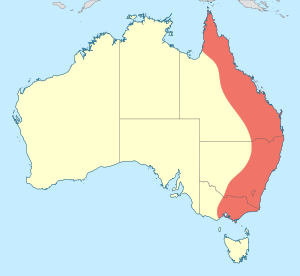Rockmasters facts for kids
Quick facts for kids Rockmasters |
|
|---|---|
 |
|
| Tropical rockmaster | |
| Scientific classification |
|
| Kingdom: | Animalia |
| Phylum: | Arthropoda |
| Class: | Insecta |
| Order: | Odonata |
| Suborder: | Zygoptera |
| Family: | Lestoideidae |
| Genus: | Diphlebia Selys, 1869 |
 |
|
Diphlebia is a group of damselflies commonly known as rockmasters. These insects belong to a scientific group called a genus. They are part of the Lestoideidae family.
Rockmasters are quite large and have thick bodies. Most species live in Eastern Australia. However, one type can be found in New Guinea. Male rockmasters have bright, striking patterns. They are often blue or bluish-green and black. Because of their beautiful blue color, they are also called azure damselflies.
When rockmasters rest, they spread their wings out wide. Their wings are usually blackish-brown or have white marks. Young rockmasters, called larvae, are wide and flat. They have special long gills that help them breathe underwater.
Contents
What Are Rockmasters?
Rockmasters are a type of damselfly. Damselflies are insects that look a lot like dragonflies. However, damselflies are usually smaller and more slender. When they rest, most damselflies hold their wings together over their back. Rockmasters are different because they spread their wings out when they are not flying.
These damselflies get their name "rockmasters" because they often live near rocky streams and rivers. Their larvae live in the water, clinging to rocks.
Where Rockmasters Live
Most rockmaster species live in the eastern parts of Australia. This includes states like Queensland and New South Wales. One special type of rockmaster lives further north in New Guinea. They prefer places with clean, flowing water, like rivers and creeks.
Types of Rockmasters
There are five known species of Diphlebia rockmasters. Each one has its own unique features. Here are the different kinds:
- Diphlebia coerulescens Tillyard, 1913 - This is known as the sapphire rockmaster.
- Diphlebia euphaeoides Tillyard, 1907 - This one is called the tropical rockmaster.
- Diphlebia hybridoides Tillyard, 1912 - You might know this as the giant rockmaster.
- Diphlebia lestoides (Selys, 1853) - This is the whitewater rockmaster.
- Diphlebia nymphoides Tillyard, 1912 - This species is called the arrowhead rockmaster.
Life Cycle of Rockmasters
Like all damselflies, rockmasters go through different stages in their life. This is called a life cycle.
Eggs
The female rockmaster lays her eggs in the water, often on plants or submerged wood.
Larvae
Once the eggs hatch, tiny larvae emerge. These larvae live underwater. They are flat and wide, which helps them hide among rocks and plants. They have special gills that allow them to breathe underwater. Larvae spend a long time growing, shedding their skin many times as they get bigger. They are predators, meaning they hunt and eat smaller water insects.
Adults
When a larva is ready to become an adult, it crawls out of the water onto a plant stem or rock. Its skin then splits open, and the adult damselfly emerges. The adult rockmaster has wings and can fly. Adult damselflies live for only a few weeks or months. Their main job is to find a mate and lay eggs, starting the life cycle all over again.
Images for kids


